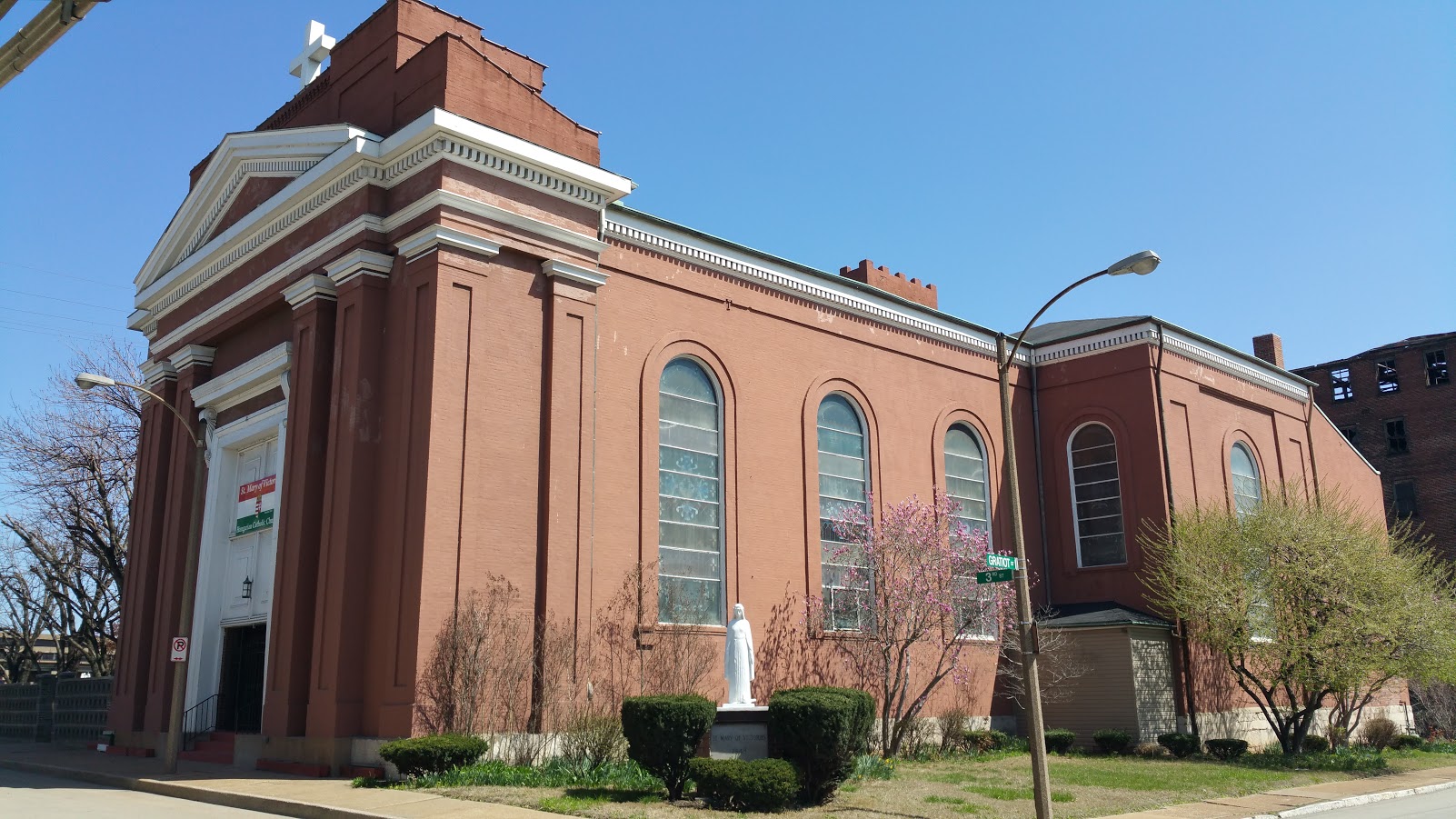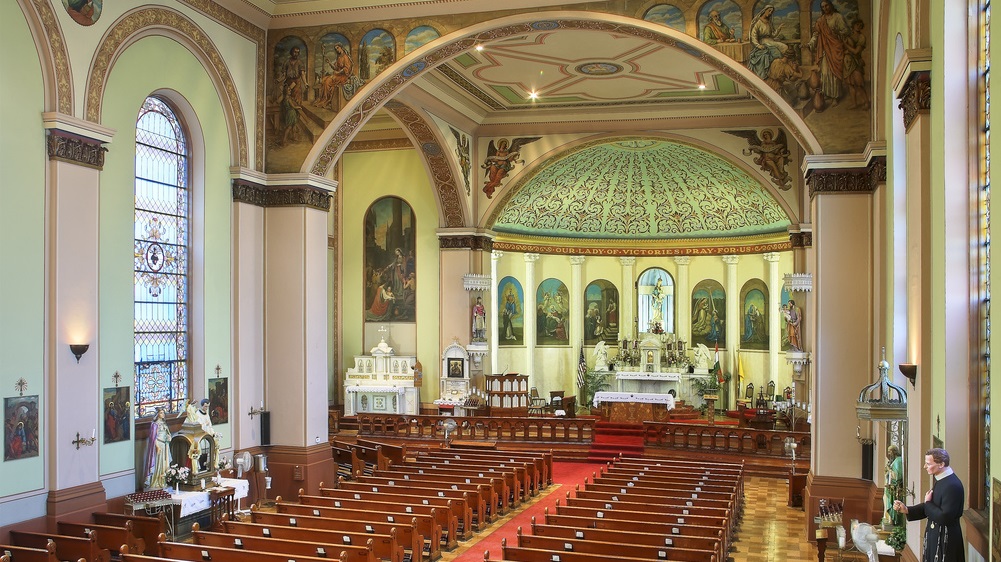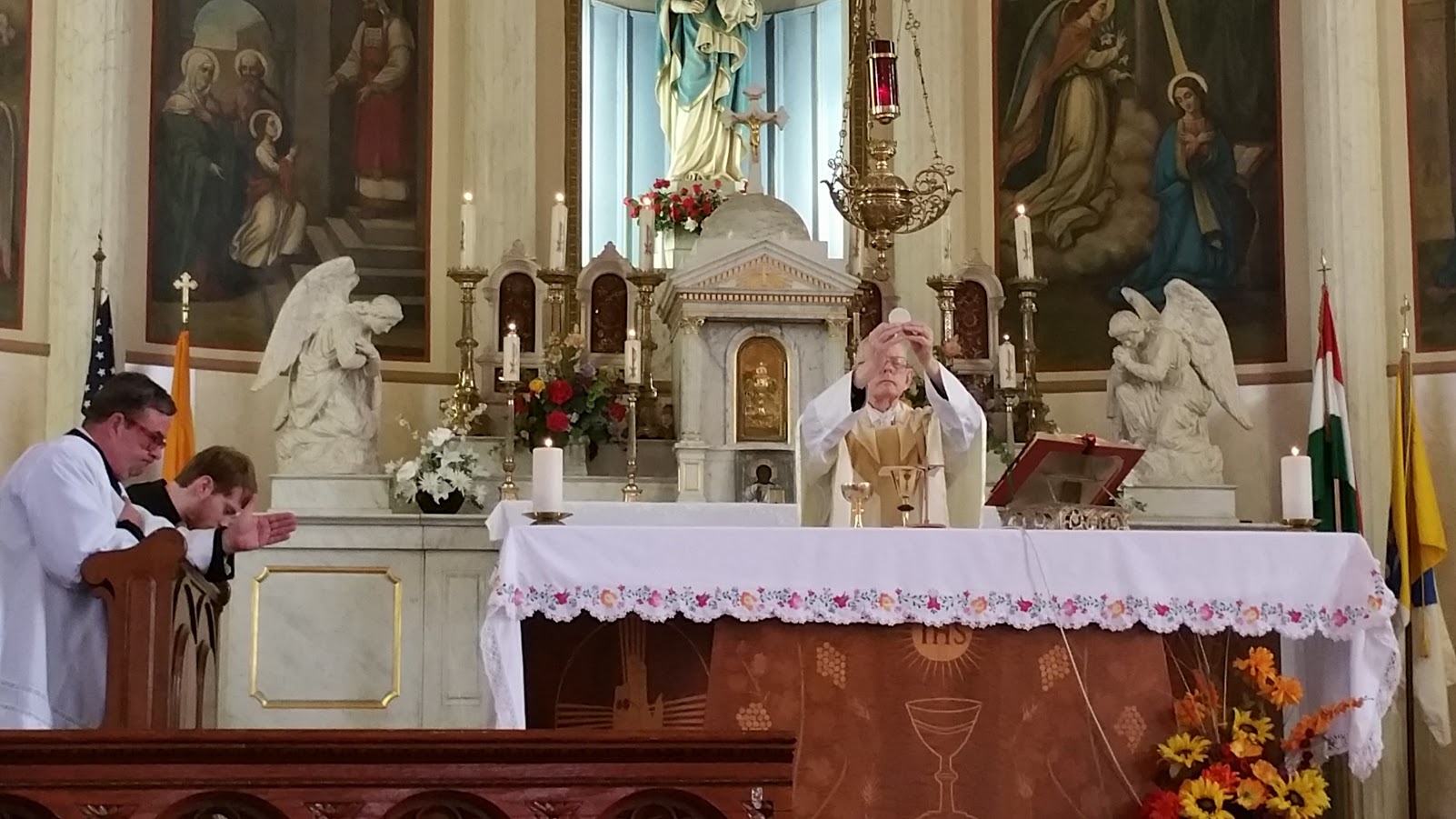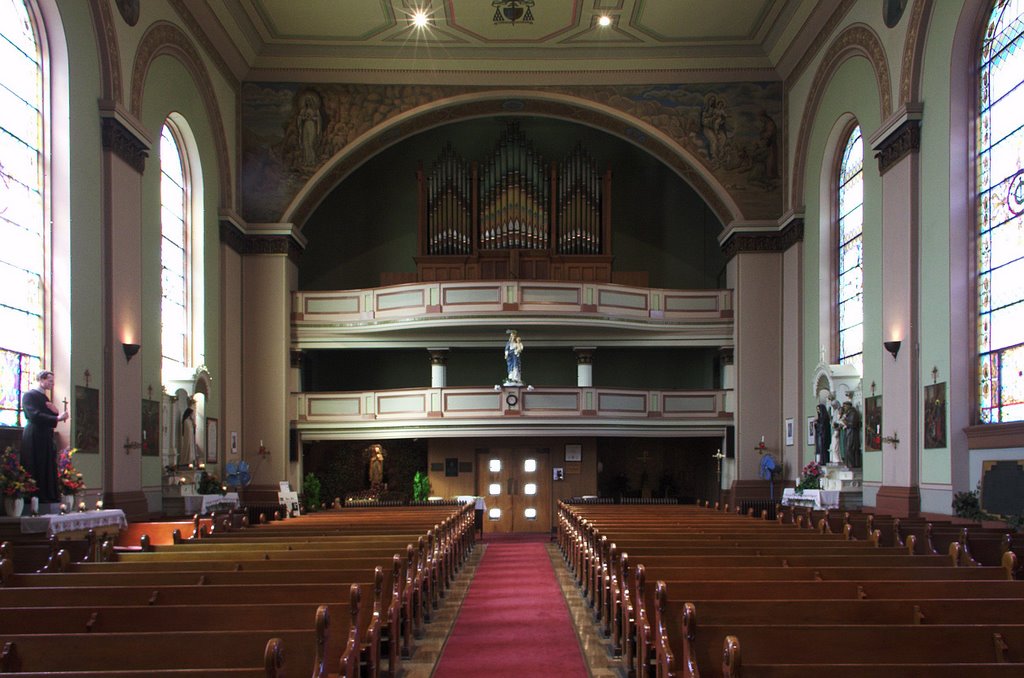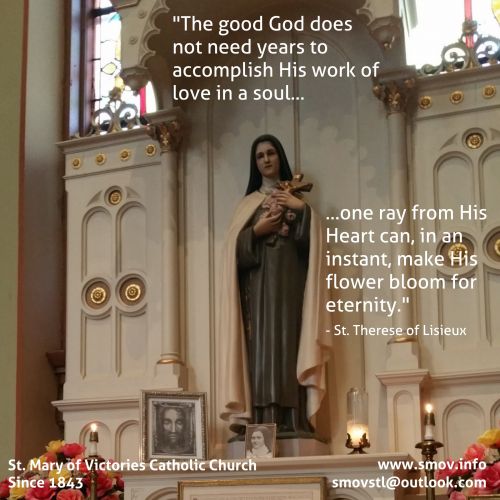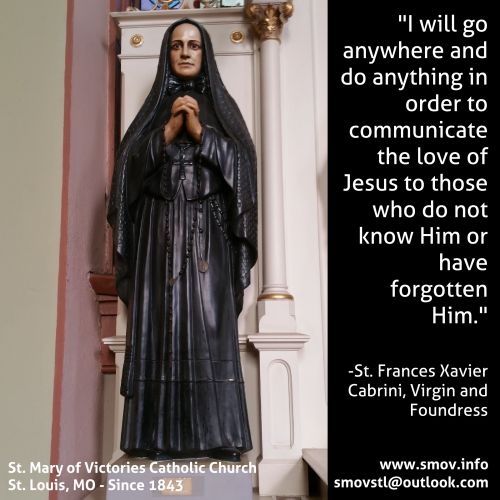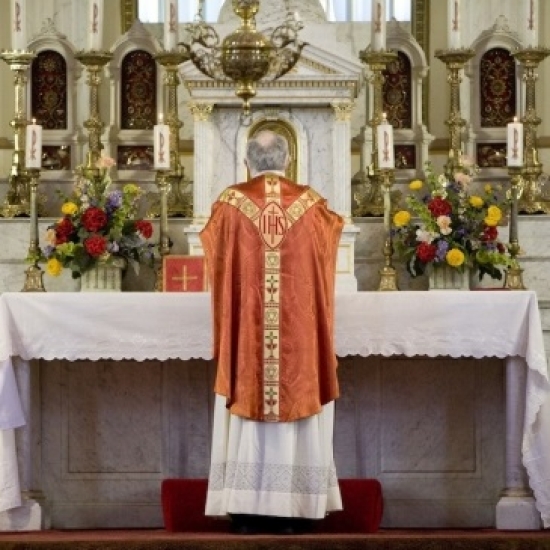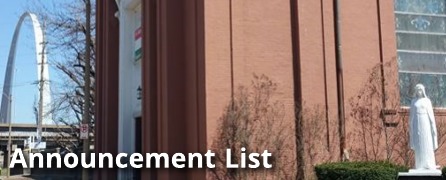The original SMV was dedicated on this date in 1844.
In the earliest manuscripts the chants of this formulary for the dedication of a church are found before the feast of the Ascension, because at Rome the dedication of the Pantheon as a Christian Church under the title of Sancta Maria ad Martyres, in the year 607, three years after the death of St. Gregory the Great, was celebrated on May 13, the same day on which St. Mary of Victories was consecrated in 1865. (Now you know why that date was chosen.) The Mass formulary was considered the crown of the church's dedication, and in singing it each year we renew our own dedication of our selves to being the living stones of Christ’s body, the Church.
Introit: Terribilis est
Gradual: Locus iste
Alleluia: Adorabo ad templum
Communion: Domus mea
Post communion: Hymn: Urbs Jerusalem beata
Ordinary from Mass XI, Credo III
The Introit antiphon has three short phrases:
-
Terribilis est locus iste:
-
hic domus Dei est, et porta caeli
-
et vocabitur aula Dei.
The first word of the Introit today again sets the tone of the day: deep reverence grips man when God approaches. The Patriarch Jacob was overcome with awe when in a dream he saw the ladder reaching up to heaven. The same feeling fills the faithful soul when it enters the church, for this is the house of God. The overwhelming gratitude that God would deign to visit this place—this was the underlying spirit of the prayers at the consecration of the church. With a ring of conviction we sing, 'This is the house of God.' And in the tremendum Mysterium of the Mass, Christ appears among us in His divinity and His transfigured humanity. Then the church becomes the gate through which heaven, yea, the Lord of heaven comes to us; it becomes the courtyard of heaven, bringing to us an anticipation and taste of the joys that await us there; it consecrates and sanctifies our souls so that one day they may inhabit the heavenly mansions. Precisely for this reason the holy reverence which overshadows the soul is not something oppressive of which we would wish to rid ourselves, but a reverence blended with an inner happiness. Exceeding lovely is the tabernacle of God among men; for the souls of men yearn and languish.
The first phrase sets in as if bowing profoundly before the holiness of the place, and has the effect of an A minor. The second phrase begins and closes with C major and has a much brighter ring. Its close fg ff cdc bears some rhythmic similarity to iste in the first phrase with its faff ed. At the same time there is a tendency toward a cadence, which in other melodies of the second mode, for example, in the Introit for the first Mass of Christmas over meus es tu, is made to stand out in sharper relief by means of e, which has the quality of a leading note. With its ecac cdf the third phrase reminds us of terribilis est of the first phrase, while at the same time it has a pressus in common with the second phrase. Thus the words domus Dei and aula Dei are given prominence. Although the text can readily lend itself to strong, almost violent accents, gentler modulations allow the twofold tristropha to graphically describe our trembling and awe for the mysteries we encounter in the Catholic house of prayer.
In the Gradual, we find again the two + two phrasing in the corpus and the verse:
-
Locus iste a Deo factus est, inaestimabile sacramentum
-
irreprehensibilis est.
-
V. Deus, cui adstat Angelorum chorus
-
exaudi preces servorum tuorum.
God has traced the plans of His Catholic Church; He has created its atmosphere and given it that supernatural strength from which its faithful can so liberally draw. These attributes are as true and real as they are mysterious; their consequences we see realized in the lives of the saints. Each church is a mystery, a Sacramentum; in it most of the sacraments are also administered. No one can rightly define it nor rightly estimate its value. In its very essence it shows forth the universal Church, the Communion of Saints, the city of God in heaven, the Bride of Christ for whom He has sacrificed Himself, that she might be glorious, without spot or wrinkle (irreprehensibilis). The Church is a holy city; she has come as a heavenly bride celebrating her espousals with Christ, the Bridegroom, in the mystery of the Mass. There God comes to us and takes up His abode among us; He becomes our God. As mysterious as it is real, the entire drama is but an anticipation and preparation for the eternal wedding feast in heaven. Then God shall wipe away all tears and in His everlasting kingdom make all things new.
The corpus is quiet and serene. Actually it has a range of only a fifth. Once the melody goes below the tonic, and once it ascends above the dominant. Inaestimabile is modeled on admirabile of the ninth Sunday after Pentecost. Over sacramentum, fgdgfg becomes gabaga. The resolved descending major chord occurs three times.
The verse exhibits great development. Its florid melisma over (cho)-rus is easily recognized; suffice it to mention only Maundy Thursday. The entire second phrase, text and melody, is taken from the Gradual Protector noster, sung in the EF as second Gradual for the Ember Saturday of Lent and in the OF on 11th Sunday in Ordinary Time. God appears surrounded by His celestial court. In many churches the mural decorations depicted the choirs of angels. The thousands and tens of thousands of angels pay Him homage and are happy in His presence, all their desires being fully realized. We, on the contrary, have many things to ask for and to lament over: we must cry: exaudi—hear us! And no matter how many or how great they may be, we may bring them all. Today, however, we will above all—Imprimis—pray for the Church, that God may protect, unite, govern, and preserve her in peace.over the entire earth. We will pray that our souls also, created and redeemed by God, and sanctified through the sacraments, may ever retain their dignity as temples of God and ever strive after greater holiness. Only then can we hope that our prayers will be acceptable to God and worthy of being heard. Here we might well ask ourselves: What must be my attitude in choir so that I may measure up to the standard of the choirs of angels?
The Alleluia verse has two phrases:
-
Adorabo ad templum sanctum tuum
-
et confitebor nomini tuo.
The beginning of this Alleluia shows some resemblance to that of the Alleluia Confitemini Domino (EF: 19th Sunday after Pentecost; OF: 25th Sunday in O.T.) On the syllable -ia a torculus and then a pressus should be sung. The close of the verse has only the torculus of the second member and the last eight notes of the jubilus. According to Peter Wagner, this Alleluia marks approximately the division between the archaic (Gregorian) and the classic (post-Gregorian) type of Alleluia. Indeed, he says that there is only wanting 'the agreement of the coda of the verse with the jubilus and its symmetrical construction and brilliant melody,' but that it shows a great step forward in comparison with the type portrayed in the three Christmas Masses.
The first phrase portrays reverence, an awe-inspired reverence in the 'holy temple' of God. The second phrase is a jubilant song of praise. Over confitebor the melisma with the form a a b is, according to Wagner, 'one of the most beautiful musical inspirations of the Middle Ages.' To the solemn ascent to high f there is a corresponding recollected descent. Care must be taken not to sing the ascending notes too rapidly. The annotated manuscripts here give all the notes the broad form. The motif f f c d is repeated delicately over ccga, followed by a repetition of the entire melisma. It would seem that we are listening to the fifth mode, were it not that abc leads us back to the seventh mode. This formula was already sung over the close of (Ado)-ra-(bo). The group over tu-(um) is enhanced over (tu)-o.
Who prays this way? In St. Gall Codex 339, this Alleluia, text and melody, is assigned to the feast of the Purification (OF: Presentation, 2 February). It is, therefore, really Christ Himself, who, in every church, at every Mass, adores the Father in spirit and in truth, who glorifies and praises Him in the measure that His infinite Being demands. Let us rejoice that we have one who can offer an adequate adoration, a worthy song of praise, and- let us strive to render this song in a manner truly divine.
The Offertory has three phrases:
-
Domine Deus, in simplicitate cordis mei laetus obtuli universa
-
et populum tuum, qui repertus est / vidi cum ingenti gaudio
-
Deus Israel, custodi hanc voluntatem.
The first phrase of the Offertory sings of simplicity and joy that should characterize our offerings to God. Simplicity here seems to have derived its bright melody from joy—and the joyjis entirely simple and unadorned. Laetus obtuli could scarce be sung with more modesty or with greater simplicity. The twofold bistropha must be sung lightly and must not be held longer than four beats. Universa can be sung with a slight crescendo. The final groups remind us of Deus.
The Gospel recounted with what readiness Zachaeus made sacrifice, and how pleased Jesus was with his zeal! The second phrase is characterized by the ''great joy" which here seeks full expression; it should be sung with a great crescendo. The heart of King David leaps with joy when he sees his people—yea, God's people—enthusiastic to bring sacrifices. Populum tuum bears some resemblance to the beginning of today's Gradual.
After the second phrase a large pause is to be made, for here a new thought, a prayer is introduced: "Keep this will!" This phrase begins with a soft, humble tone, expressing the wholehearted longing for God's helping grace, while the following custodi is given some prominence. On the closing syllable of voluntdtem the joy of the first two phrases is once more felt. Here two motifs are interwoven: dc gfg and gf dcf, and in both of them we find an echo of fg dcff over obtuli. Domine Deus possesses the simplicity and modesty of the first phrase.
The Secret continues the spirit of this beautiful Offertory: 'Grant that all we...by full and perfect devotion, be acceptable to You both in body and soul; that we who now lay our votive gifts before You, may by Your help be found worthy to win Your everlasting rewards.' As a pledge for this we hear these words from the lips of the Lord: 'This day I must stay in your house.' It is in Holy Communion that He deigns to come into 'our house' to sit at meat with us; and then we experience that salvation has entered into our house, into our heart.
The Communion antiphon has two phrases. (The second is long, so find a spot to steal a breath.)
-
Domus mea, domus orationis vocabitur, dicit Dominus
-
in ea omnis qui petit, accipit: et qui quaerit, invenit; et pulsanti, aperietur.
This house is a house of prayer. The first two members of this Communion would, as it were, write these words in large letters over the entrance of the church; hence the many large intervals. The accented second domus sets in with a fourth; the fifth c-f, and the fourths c-g and b♭ -f occur at varying intervals. The third member with its sequence-like passages is then a quiet thesis after the great arsis. Its closing cadence was heard a pitch higher over mea. This unusual inception for a piece of the fifth mode demands clever manipulation on the part of the organist.
The second phrase has only seconds and thirds; its last member has the sole fourth. Throughout a preference is shown for the ascending and descending major chord f-a-c: qui petit, (quae)-rit, inve-(nit), (a)-perie-(tur). Omnis—every one—rightly receives a special accent. In the rendition a slight pause might separate the petition from its fulfillment, thus: qui petit—accipit, etc. The second phrase, therefore, explains why the church is a house of, prayer; it is there, namely, that our prayers are heard. Would that all the churches of the Catholic world might relate how much consolation they have dispensed, how many tears they have dried! Today the words of this Communion have again been realized in holy Mass. The heavenly Father did not give us stones when we prayed for our daily bread. We sought mercy and peace and found them. We knocked, and the gates of heaven opened and rained manna. Indeed, in the ultimate analysis we were not the ones who asked and sought and knocked; Christ is our intercessor; He it is who prays for us continually.
This Communion song is at the same time a song of invitation, calling us to return soon and often to this place of intercession, so that we also may share in its blessings. The dedication of the church! Our soul also celebrates the feast of its dedication which took place at Baptism; this is the secondary thought that permeates the prayers of the rite of consecration. Just as in the dedication of the church, so at Baptism the priest commanded the evil spirit to depart from us; and after the saving waters had been poured upon our heads, the Holy Ghost with the Father and the Son made our souls their sanctuaries. And the holy oil and chrism with which we, as also the church, were anointed, was the pledge of our participation in the riches of God's infinite grace. We can, therefore, predicate of our soul the words: This is the house of God. If we make these truths a part of our everyday life, then our prayers and song will resound with a pure, full ring in the house of the Lord!
Blessed city, heavenly Salem (Tune: Westminster Abbey)
1. Blessed city, heavenly Salem,
vision dear of peace and love,
who of living stones art builded
in the height of heaven above,
and, with angel hosts encircled,
as a bride dost earthward move;
2. from celestial realms descending,
bridal glory round thee shed,
meet for him whose love espoused thee,
to thy Lord shalt thou be led;
all thy streets and all thy bulwarks
of pure gold are fashioned.
3. Bright thy gates of pearl are shining;
they are open evermore;
and by virtue of his merits
thither faithful souls do soar,
who, for Christ's dear Name, in this world
pain and tribulation bore.
4. Many a blow and biting sculpture
polished well those stones elect,
in their places now compacted
by the heavenly Architect,
who there-with hath willed for ever
that his palace should be decked.
